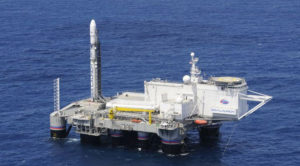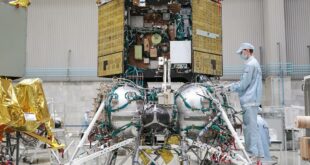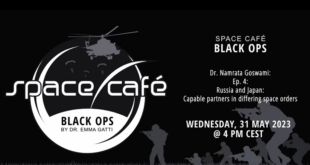
The history of the Sea Launch platform began in 1995 when a consortium of four companies from the United States, Russia, Norway, and Ukraine (with 40, 25, 20 and 15% shares respectively) was established. Cooperation duties were as follows: the Norwegian side provided the self-propelled Ocean Odyssey oil platform, which was converted into a floating spaceport at a Russian shipyard in Vyborg. Also, according to various estimates, the Russian side produced 70-85% of spare parts for the Zenit-3SL rocket developed by Ukraine. The rocket was equipped and assembled in Ukraine. Following the assembly, the launch vehicle was delivered to Long Beach airport (USA), where it was then docked with the satellite and fairing assembly, transported to the floating spaceport and launched from the Pacific Ocean off Christmas Island.
Launches from the platform began as early as May 1999, but they were not as frequent as originally planned: by April 2009, only 30 launches had been performed. As a result, the company declared bankruptcy in June 2009, leading to the transfer of 95% of its shares to the Rocket and Space Corporation Energia in April 2010. All launches from the platform were therefore suspended for over a year, but in January 2011 launches were renewed for a brief period. Unfortunately, the political tensions between Russia and Ukraine resulted in mothballing the platform in August 2014, which continues to this day. In total, 36 rockets with 177 tons of payload were launched from the platform from 1999 to 2014, with 32 successful, 3 failed and 1 partially successful launch.
Soon negotiations began between the Rocket and Space Corporation Energia, the United States, China, Brazil, the UAE and Australia to sell the Sea Launch. As a result of the negotiations, the S7 Group holding and the Rocket and Space Corporation Energia signed a contract for the purchase of the maritime launch platform at the International Astronautical Congress in Guadalajara (Mexico) in September 2016. As part of this transaction, the newly formed S7 Space company became the owner of the Odyssey launch platform, the Sea Launch Commander assembly ship, and the Sea Launch trademark. The transaction value was estimated by the holding to amount to more than $150 million. As part of the bargain, the Rocket and Space Corporation Energia (a part of the Roscosmos State Corporation) promised S7 Space help with resuming Zenit rocket launches. Immediately following the decision, S7 Space announced that it was going to make up to 70 launches over the next 15 years.
To fulfill these ambitions, the company planned to purchase several Zenit rockets for early launches. Zenit had been previously used to launch satellites from Sea Launch (according to the company, this would have returned the invested funds as soon as possible and also get a share of the space launch market). Later on, it was suggested to switch to the Soyuz-5 launch vehicle, which was planned to be developed on the basis of the Zenit rocket using only Russian-made parts. The beginning of Soyuz-5 tests was planned for 2022.
S7 Space started implementing this ambitious goal by signing a contract in June 2017 with the Ukrainian Production Association Yuzhny Machine-Building Plant for the supply of 12 Zenit-3SL launch vehicles. Demothballing of Sea Launch was scheduled for May and June 2018. It was also reported that S7 Space was ready to order up to 50 rockets from Roscosmos with an option for another 35 if Soyuz-5 met the company’s requirements. However, as the general director of S7 Space Sergey Sopov pointed out, the Russian government had lost interest in his company immediately after the deal had been closed. To date, the company has been trying to receive permission for the supply of the necessary parts of the Zenit launch vehicle to the Ukrainian Production Association Yuzhny Machine-Building Plant for 10 months, which meant that the earlier deadlines had not been met. Also, Roscosmos has still not responded to the company’s proposal on the order of 85 Soyuz-5 launch vehicles, although the company has already received proposals to build analogs of Zenit from representatives of the Chinese space industry and certain other foreign companies. In addition, S7 Space has doubts regarding the cost of Soyuz-5, although Roscosmos has responded that it is too early to discuss the cost of a rocket that is still under development. Moreover, Sergei Sopov has voiced his doubts that flight tests of the Soyuz-5 rocket will begin on schedule.
In the current circumstances, the company has been suffering from considerable financial losses as the conservation of the maritime platform costs about $20 million annually. As a possible solution, S7 Space has offered to develop a new reusable rocket powered by the inexpensive NK-43 engines, which are an upgrade of Soviet NK-33 engines, developed for the Soviet lunar program. This new rocket would be used to launch satellites from Sea Launch. Under this project, it was planned to build a new plant to produce rocket engines in Samara, and the total amount of investment in this project was estimated by the company at $150-200 million. However, the company has not received a response to this proposal either.
S7 Space has so far been able to participate in only one Zenit rocket launch from Baikonur as the launch operator for the Rocket and Space Corporation Energia. However, neither the Corporation nor other divisions of Roscosmos have Zenit rockets available for launch at the moment. Also, the decision to resume production is yet to be made. In response to the current situation, Sergei Sopov has recently said that unless the current problems are solved, his company will have to re-sell the maritime platform back to the Rocket and Space Corporation Energia. Sopov has also emphasized that the Sea Launch is one of the few remaining joint projects of Russia and the United States in the high-tech sphere, and that continued cooperation could potentially help improve the relations between the two countries.
One way or another, if a solution to the problem around the maritime platform is not found, control of Sea Launch may return to the Russian government, and S7 Space company may cease to exist.
Denis Nyrkov is a science and space exploration educator, member of the Mars and Planetary society. Author of approximately one hundred articles for various online sources and an advocate of human missions to Mars.
 SpaceWatch.Global An independent perspective on space
SpaceWatch.Global An independent perspective on space




